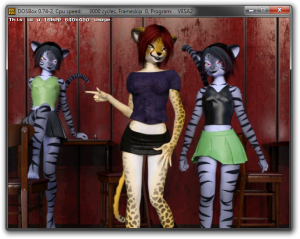We’re all familiar here with the classic 320×200 pixels, 256 color screen mode popularized by the VGA video card, colloquially known as Mode 13h. Most old DOS games from before a particular point in time used it. But what if you want or need bigger? Or more colors? Enter the Super VGA cards with their extended VESA modes.
These VESA modes number 100h and higher, but which exactly are available and what their specs are depends on your exact hardware. As such you can’t rightly assume a certain mode is available and will be that particular resolution and color depth. What you’re supposed to do is ask the system what VESA video modes are available, walk the list to see if you find the one you need, and note its number.
All I have is a copy of DOSBox and a copy of VirtualBox, and of vesachk.exe, available here if you want to try it out yourself. This application gives you that list. Now, the two systems yield vastly different results, mirroring differences in video hardware. DOSBox for example emulates some form of S3 card.
I’ve noticed that when an SCI32 game is made for low-res it runs in plain ol’ Mode 13h, but if it’s meant for higher it’ll use Mode 101h. That’s one of the few in the list that DOSBox and VBox agree on — it has 640×480 resolution at 8 bits per pixel, packed, starting at 0xA0000000.
On the one hand, a regular old 16-bit DOS application wouldn’t be able to address all 307,200 pixels at once the way you can in mode 13h. On the other, a 32-bit application would have direct access to the full linear frame buffer no matter its size. A 16-bit application would need trickery to reach any pixel beyond a certain point, setting the window registers to basically shift the next part of video memory into that same 64 kb block.
This is why SCI32, when switching to mode 13h, just does so:
void Vga::Set320x200()
{
union REGS reg;
reg.w.ax = 0x0013;
int386(0x10, ®, ®);
SetVideoMode(1); // clear all video memory
SetVideoMode(0); // back to Normal Mode 13
lenx = 320;
leny = 200;
}
But when it switches to mode 101h, it jumps through several hoops. First it checks if VESA is supported at all, then it switches to mode 101h, and then it does some more checks to see if things are as they should be, bailing out if they’re not.
And that’s all good.
But what if you were to find a VESA video mode that was 320×200 with 256 colors? Is there such a thing? A redundancy with mode 13h? As a matter of fact, there is! On the S3 emulated by DOSBox, it’s VESA mode 150h, and once you switch to it things work exactly the same as in mode 13h, except the memory access timing or whatever is different.
; VGA mode 13
mov ah, 0x00
mov al, 0x13
int 0x10
; VESA mode 150h
mov ax, 4F02h
mov bx, 150h
int 10h
But on whatever VBox has to offer, which is a vastly longer list with about a hundred more modes, this could be 146h, 346h, 546h, or 746h. And that’s why you really should ask the system about it!
But SCI32 basically assumes 101h is what it needs to be and presumably the folks at Sierra tested a bunch of contemporary cards and found this to be true.
Fun fact: SCI16 has all its video driver code in files like VGA320.DRV, but SCI32’s VGA.DRV is practically empty. It’s technically a valid SCI driver file but it’s basically just a header. Same with its VESA.DRV. All their code is in the interpreter itself, much like the mouse driver. It’s only there so the installer can offer it and the interpreter can determine which was chosen. And even then, the interpreter for later high-res only games like Gabriel Knight 2 will happily ignore all that.





